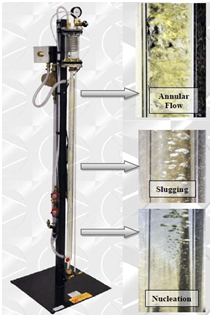● Safe and Suitable For Unsupervised Student Operation.
● Responds Rapidly to Control Changes.
● Negligible Operating and Maintenance Costs.
● Two year Warranty.
Introduction
In all types of vapour generator (e.g. boilers and evaporators) the processes of boiling, and sometimes superheating, take place within metal tubes. Although these processes are very important and interesting and can have a considerable effect on the performance of the plant, they are difficult to see or even visualise.
The H411 Hilton Flow Boiling Demonstration Unit has been produced to provide students with a clear visual demonstration of what is happening inside the vapour generating tubes of practical plants. In this unit it is possible to see all the processes and types of flow involved during an actual (NOT simulated) evaporation process, from sub-cooled liquid to superheated vapour. The unit will be of interest to those involved with courses for:
• Chemical Engineers
• Energy Management
• Plant and Process Engineers
• Marine Engineers
• Mechanical Engineers
• Refrigeration Engineers
Experimental Capabilities
• Demonstration of a heating process accompanied by vapour formation within a tube, including
Circulation promoted by natural convection
2. Convective heat transfer to sub-cooled liquid
3. Nucleation in sub-cooled and saturated liquid
4. Slugging
5. Annular flow
6. Droplet entrainment
7. Complete dry out to superheated vapour
• Demonstration of two phase flow with increasing vapour content
• Demonstration of effect of air in condensers
Description
The system operates on a solvent at below atmospheric pressure.
Liquid is fed by a fine control valve to the lower end of the vertical generating tube, which is the core tube of a concentric tube heat exchanger constructed from Pyrex glass. Heat transferred from hot water flowing through the jacket of the heat exchanger, causes the compound to boil.
The vapour formed enters a thick walled glass chamber in which a water cooled coil causes it to condense. The liquid formed is returned to the generating tube via the control valve.
Hot water for the jacket is provided by a 500W heating element in a second glass walled chamber. Vigorous circulation of the water is ensured by a glandless centrifugal pump.
A water driven air ejector is used as required, to extract air from the condenser. The unit is floor mounted but occupies only 0.25m² floor area.
Operation
Having fully opened the flow control valve, the correct quantity of compound is charged into the condensing chamber, and the filling point closed. Using the air ejector, the condensing chamber is evacuated until the saturation pressure is reached.
Cooling water is now circulated through the condenser and the water heater and circulating pump are switched on.
In a short while, natural circulation (due to density changes) will be observed clearly demonstrating natural circulation in a non-vapour-generating liquid heater. As the water temperature rises, nucleation will occur inside the generating tube, a short distance above the lower end.
The bubbles formed, rapidly increase in number and volume as more heat flows into the liquid and vapour mixture as it rises through the generating tube. Due to the great increase of volume, the velocity of the mixture increases rapidly towards the top of the tube, and a stream of mixture is ejected from the generating tube into the condensing chamber. The need for mechanical separation of liquid and vapour in a practical vapour generator operating in this way is obvious to the observer.
If the flow rate is now reduced by partly closing the flow control valve, the complete process of evaporation, from the warming of sub-cooled liquid to the generation of wet, and finally, superheated vapour, can be observed within the length of the generating tube.
This demonstrates the action of a “once-through” boiler, and students will readily appreciate the dangers of tube metal failure in the latter stages of heating in a fossil fuelled boiler of this type.
In this mode, the unit is probably at its most useful since it fully demonstrates all the flow boiling regimes described in text books i.e.
warming of sub-cooled liquid,
nucleation in sub-cooled liquid,
nucleation of saturated liquid,
bubbly flow,
slug flow,
annular flow,
droplets in suspension,
superheated vapour
Since the system operates below atmospheric pressure, air can easily be admitted, and this further extends the use of the unit:
• Air in the condenser will greatly reduce the heat transfer coefficient of the water cooled coil and a reduction in the rate of condensation and consequent rise of pressure will be immediately observed.
• The liquid in the generating tube which was previously saturated liquid is now compressed liquid. This has an immediate effect on the bubble formation in the generating tube.


